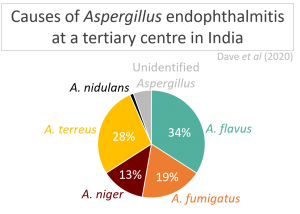Submitted by GAtherton on 11 October 2016
Aflatoxins have previously been shown to be a heavy burden on some of the world’s poorest populations (for more information click here).
Aflatoxins are a by-product of the metabolism of Aspergillus flavus and Aspergillus parasiticus. Climate change and the accompanying adverse weather conditions (more information) create a favourable environment for the production of aflatoxins. High levels of the aflatoxin in maize have forced regulators to confiscate grain and prevent its entrance into the market, resulting in food shortages.
Testing for aflatoxin infestation has previously been difficult, however; a test kit has recently been launched by Egerton University. The kit uses a small testing strip to detect aflatoxins while sensors and a smartphone application deduce the level of aflatoxin infestation and transmit the data in real time to servers at the university. This helps scientists understand the level of the fungal infestation. Test kits can be distributed to regional cereal collecting points and the data collection will provide information on the aflatoxin level in the region.
The Kenya Agricultural and Livestock Research Organisation (KALRO) in partnership with the United States Department of Agriculture, Agriculture Research Services (USDA-ARS), has also been working on technology to help solve the problem. Their biocontrol technology, Aflasafe KE01 TM is reported to reduce aflatoxin contamination by up to 80%. It is made up of strains of the non-toxic fungus, which, when introduced into the fields, outcompete and reduce the population of the toxic ones, thereby reducing contamination.
The development of new technologies is an important advancement for local farmers and will help to mitigate the damaging effects of aflatoxins.
News archives
-
Title
Date



